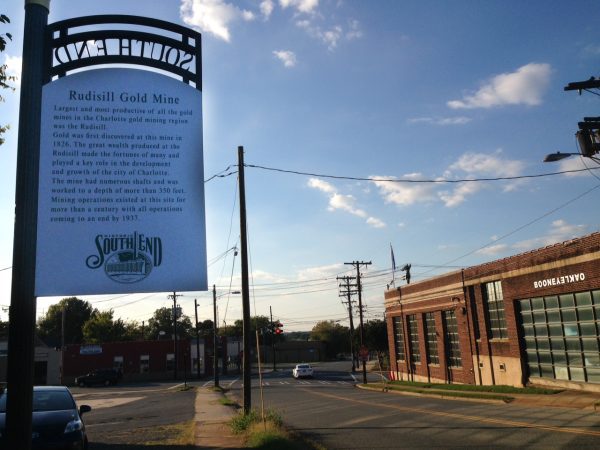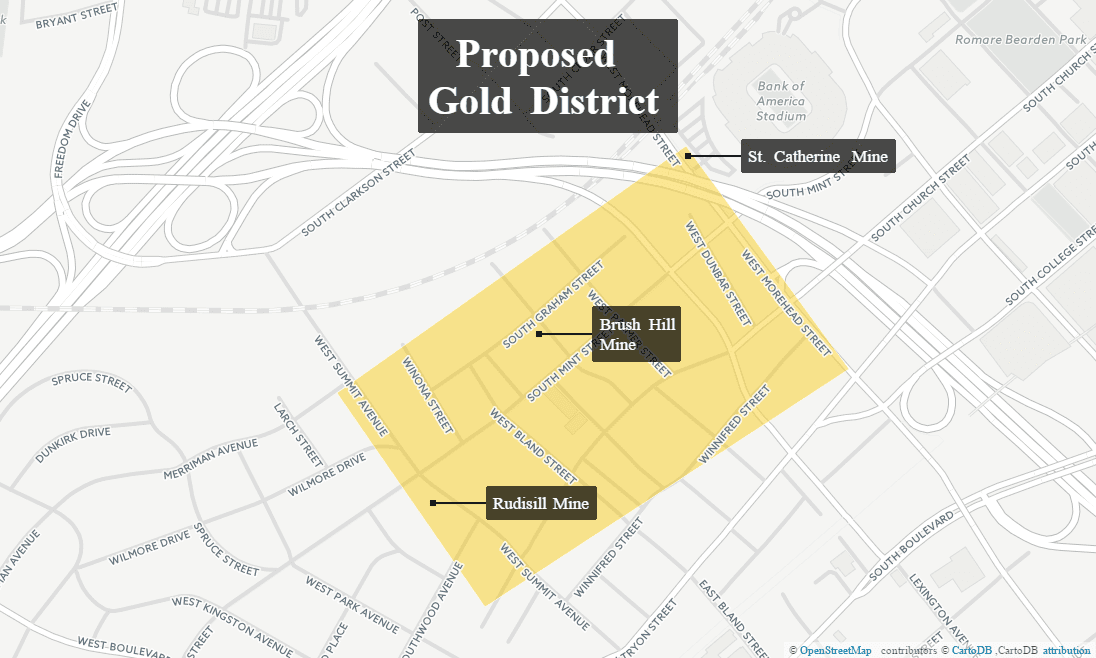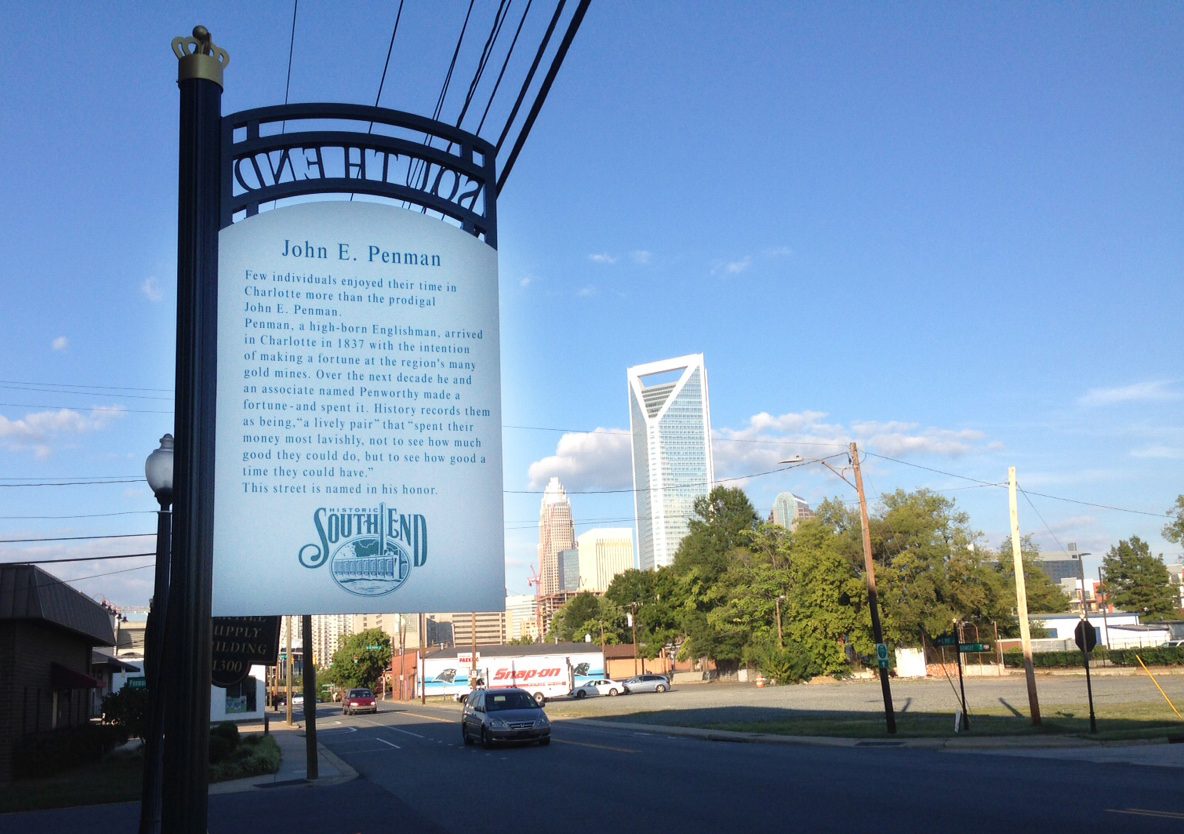South End area with unique history wants new, unique zoning

A proposal working its way through the city zoning process could create something new for Charlotte: a special kind of zoning designed specifically for one neighborhood.
The proposed Gold District would give a section of the larger South End area its own zoning standards, tailored to what businesses and property owners in the area say they need in order to attract more redevelopment. It’s an approach never before tried in Charlotte, and whether the city’s planning department, planning commission and City Council will ultimately support the idea is not yet clear.
The idea is one part of a larger initiative to create a special identity, based on the area’s gold-mining history, for land roughly bordered by West Morehead Street, South Church Street, West Summit Avenue and South Graham Street.
Several of Charlotte’s most significant 19th-century gold mines were in that area. But in the almost two centuries since Charlotte’s gold rush – the first in the then-new United States – the mines and their impact on the city’s and the state’s history have been, if not entirely forgotten, a less prominent part of local lore and memory.
“If you ask anyone who’s come here in the past 10 years why we’re here, they’d say ‘banks,’ ” Gold District enthusiast Mike Sullivan said at an August event at Unknown Brewing Co. “The real reason Charlotte is here is gold mines.”

To help highlight the gold-mining history, Charlotte Center City Partners has erected three historic markers, two on South Mint Street and one on West Summit, describing some of the gold-mining characters and the importance of the mines.
“Few individuals enjoyed their time in Charlotte more than the prodigal John E. Penman,” says one, on Mint Street near Penman Street, named for the aforementioned adventurer. “Penman, a high-born Englishman, arrived in Charlotte in 1837 with the intention of making a fortune at the region’s many gold mines. Over the next decade he and an associate named Penworthy made a fortune – and spent it.
“History records them as being, ‘a lively pair’ that ‘spent their money most lavishly, not to see how much good they could do, but to see how good a time they could have,’ ” the marker continues.
While less sexy than gold-mining, the proposal that’s moving through the city zoning process, would be, in its own way, a first for the city. It comes as several older, in-town neighborhoods such as South End, NoDa and Plaza Midwood are seeing rapid development and multiple development proposals. Residents and property owners worry about several issues:
- Will intense, high-density apartment developments alter the look and feel of older residential neighborhoods such as Dilworth, Sedgefield and Elizabeth?
- Are the design requirements for multifamily projects so weak that what’s getting built will hurt the possibilities for better designed projects? This is a concern voiced by, among others, Michael Smith of Charlotte Center City Partners, who told a forum last month “We need to raise our minimums, because minimums become the standard.”
- Will development pressure force the ouster of small, local businesses and the demolition of older, smaller buildings in favor of large, expensive ones? [See “Can Plaza Midwood save the places that matter? 4 tools that might help.”]
- Are current city requirements for things such as loading docks and trees so inflexible they make it hard for older buildings to be reused?
The proposed Gold District would make a change in the city’s zoning ordinance, called a text amendment, in order to create an additional zoning overlay district. An overlay district is a set of development and design standards tailored to apply to an area but not changing the underlying land uses allowed there. Charlotte’s existing overlay districts are local historic districts, watershed protection areas, transit-supportive districts and pedestrian-oriented districts.
What makes the proposed Gold Overlay District unique is that, unlike the city’s other overlay zones, it’s designed to apply to only one area. “There is no precedent for that in Charlotte,” interim Planning Director Ed McKinney said in an interview. “We have to be very careful about setting that precedent.” (Although a one-neighborhood-specific overlay district would be a first in Charlotte, it would not be unique in North Carolina, although it’s not a commonly used tool, according to David Owens, Gladys H. Coates Professsor of Public Law and Government at the UNC School of Government.)
At an August event to promote the Gold District idea, planning consultant Walter Fields, who drafted the proposed overlay text amendment as a volunteer effort, described it as a “real grassroots” initiative, undertaken at the initiative of businesses and property owners in the area. Amid rising property values, he said, “We’re saddled with old regulations.” The overlay district, he said, is a way to apply urban standards to what is obviously an urban area that now has zoning standards more suited for a suburban area.
“This is a one-of-a-kind thing,” Fields said. “You can’t take this [the proposed overlay] out to Highway 51. You can’t even take it to NoDa.”
McKinney, the interim planning director, said the city planning staff is trying to understand whether it makes sense to create a new overlay instead of making changes in an already adopted overlay district, such as the transit-supportive district overlay.
If the City Council votes to create the Gold Overlay District, then a separate decision would be needed to apply that newly created type of zoning to the area in South End. A public hearing, originally set for September, has been postponed until Dec. 14.
